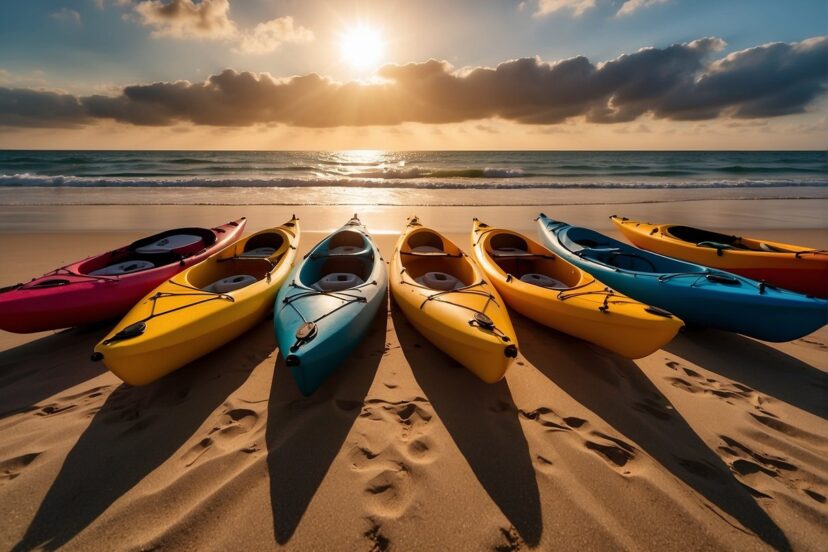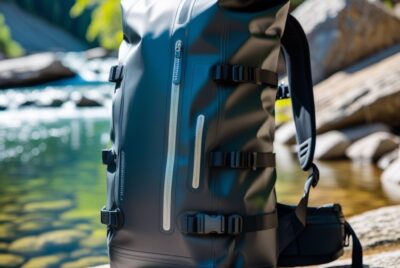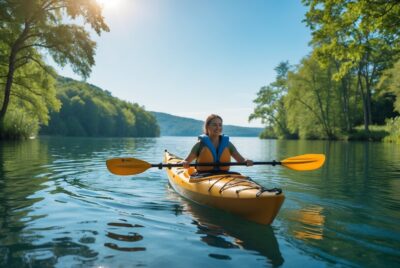Hurricane Kayaks: An Expert Guide to Performance
*We may earn a commission for purchases made using our links. Please see our disclosure to learn more.
Hurricane Kayaks: An Expert Guide to Performance and Selection
I’ve been researching and discovering the various offerings of Hurricane Kayaks, a brand known for its innovation in creating lightweight kayaks suited for a range of paddling experiences. As someone who values time on the water, I find that the diverse selection from Hurricane caters to different preferences, whether one is in search of super-stable recreational kayaks, agile day touring boats, or the freedom of sit-on-tops.

With an emphasis on construction quality and performance, Hurricane Kayaks stand out due to their lighter weight when compared to traditional polyethylene kayaks. This significant reduction in weight makes transportation and handling much easier, fostering a greater sense of freedom as you prepare to launch your kayak and embark on your aquatic adventures. For the environmentally conscious, it’s a noteworthy point that Hurricane Kayaks are also known for their use of trylon materials, which are friendly to the environment due to their recyclability.
My examination has led me to understand that ease of use and enjoyment are core principles that drive Hurricane’s design philosophy. The company’s insistence on ensuring that time spent in their kayaks translates to the “time of your life” speaks volumes about their confidence in product satisfaction. This sentiment, coupled with options for kayakers of all levels, positions Hurricane Kayaks as a compelling choice for enthusiasts looking to purchase a new kayak.
Design and Construction of Hurricane Kayaks

Hurricane Kayaks prides itself on its innovative approach to kayak design and construction. As a leader in lightweight kayak crafting, I know that their kayaks stand out because they are built with Trylon ABS plastic—a form of thermoplastic known for its resilience and UV resistance. This material not only makes their kayaks light but also gives them an edge in durability and performance.
The hulls of Hurricane Kayaks are carefully designed to balance the need for speed, stability, and handling. By using Trylon ABS plastic material, I can emphasize that the kayaks not only weather the elements well but also maintain their appearance over time due to the inherent protection against fading.
Key Aspects of Construction:
- Material: Trylon ABS plastic, lightweight yet robust for various kayaking conditions.
- Hull Design: Engineered for efficiency in water, meeting the needs of both novice and experienced paddlers.
- Weight: Models start at remarkably light weights, enhancing portability and handling.
Constructing kayaks from Trylon means the integration of lightweight materials without compromising on the craft’s integrity. As a result, Hurricane Kayaks delivers unmatched quality in their products, making them a wise choice for anyone looking to invest in a kayak that is easy to transport and enjoyable to paddle. My understanding of their process assures me that each kayak represents their commitment to innovation and excellence in the world of paddling.
Recreational and Touring Models of Hurricane Kayaks

I’ll introduce you to the diverse range of Hurricane Kayaks specifically designed for leisure and exploration. We’ll look at a variety of models that emphasize lightweight construction, performance, and comfort.
Recreational Kayaks
The Santee Series by Hurricane stands out with its light build and generous cockpit size, providing comfort and ease of entry. Models like the Santee 116 and 116 Sport, made of high-quality ABS plastic, offer a balance of stability and smooth tracking, suitable for calm waters and short day trips.
Touring Kayaks and Day Touring Options
The Tampico 130 represents Hurricane’s commitment to performance in touring kayaks. It’s agile and designed for day touring, built with lightweight materials to enhance speed and glide for longer distances on the water.
Sit-On-Top Kayaks and Their Advantages
Among sit-on-top kayaks, the Skimmer Series is noteworthy. The Skimmer 116, in particular, offers a lightweight ABS construction and performance-focused design. These kayaks are a preferred choice for warmer climates where ease of entry and exit is crucial.
Fishing Kayaks Features
Fishing enthusiasts appreciate the specialized features of Hurricane’s fishing kayaks, like increased storage, stable platforms, and accessory tracks. The Sweetwater 126, for example, combines practical fishing outfitting with efficient hull designs suitable for a variety of water conditions.
Tandem Kayak Varieties
For those who prefer to paddle in pairs, Hurricane’s tandem models like the Skimmer 140 Tandem cater to double paddling efficiency. These kayaks offer comfortable seating and stability without sacrificing performance.
Specialty Kayaks
The Prima 125 Sport is one of the specialty kayaks designed by Hurricane to accommodate paddlers looking for a hybrid of performance and recreational use. It features a large cockpit and customizable outfitting for various paddling conditions.
Innovations and Design Features
Hurricane has incorporated multiple innovative features across its models, emphasizing performance hulls, lightweight yet durable materials like polyethylene and ABS, and advanced outfitting designs for versatile kayak experiences.
Comfort and Accessibility
With their First Class Seats and adjustable outfitting, Hurricane Kayaks prioritize paddler comfort and accessibility. Large cockpits in the recreational models ensure easy access, while foam pads and adjustable hardware add to the overall comfort.
Safety and Stability Attributes
The built-in bulkheads, bow hatches, and secondary stability features in Hurricane’s kayak models emphasize safety on the water. They ensure dry storage and reliable performance even when the paddling environment becomes more challenging.
Advanced Performance Capabilities
Finally, for the performance-oriented paddler, Hurricane kayaks offer models designed to track and glide through the water with ease, supporting a fast-paced kayaking experience. Advanced design elements ensure that their kayaks remain stable and responsive under various conditions.
Material Benefits and Sustainability of Hurricane Kayaks

When assessing kayaks, the choice of material directly relates to their performance, durability, and environmental impact. I prefer to highlight the use of Trylon in Hurricane Kayaks, which has distinct advantages. This ABS plastic construction ensures that the kayak is not only durable but also lightweight. I’ve observed that kayakers appreciate the reduced weight for easier transportation and handling, especially when faced with the task of carrying their kayak over land.
Durability is a key aspect of sustainable products. By employing Trylon, Hurricane Kayaks offer a robust solution capable of handling various water conditions while minimizing the need for frequent replacement. This material is tough against abrasions and impacts, which is critical for longevity.
Eco-friendly materials are increasingly important for the environment. It’s encouraging to see that Hurricane Kayaks address sustainability concerns through their material choices. Producing lightweight kayaks also means a lighter carbon footprint during transportation.
A proud point to note is that these kayaks are Made in the USA, which often suggests shorter supply chains and supports local economies. Local manufacturing can correlate with stricter environmental regulations, potentially leading to more responsible production practices.
Here’s why I consider these kayaks a responsible choice, given their material benefits and sustainability attributes:
- Trylon ABS Construction: Enhanced performance and durability
- Lightweight: Easier transportation and handling
- Durability: Long-lasting with less need for frequent replacement
- Eco-friendly Materials: Conscious of environmental impact
- Made in the USA: Supports local economies and can lead to more responsible production practices
Practical Aspects of Kayaking
In this section, I’ll explore essential practical considerations surrounding the use of Hurricane Kayaks, from how they handle on the water to their environmental impact.
Handling and Maneurability
Hurricane Kayaks are recognized for their excellent stability and maneuverability, which are critical when I’m out on a lake or navigating the challenges of day touring. The use of lightweight materials allows these kayaks to glide smoothly and track well, and some models include a rudder, which significantly enhances control in wind or currents.
Transportation and Storage
One of the many perks of owning a Hurricane Kayak is the ease of transportation and storage due to their lightweight construction. Even the larger recreational models can weigh as little as 45 pounds, making them manageable for me to lift onto a roof rack or cart. Their compact designs don’t require extensive clearance, meaning I can store them in my garage without worrying about space.
Waterside Activities and Compatibility
Hurricane Kayaks are versatile, suitable for various waterside activities such as recreational paddling and fishing. Their stability makes them compatible with tranquil lake waters but also robust enough to handle choppy conditions. With decks designed to secure gear, these kayaks offer functionality for a pleasant day out on the water.
Environmental Considerations
I’m conscious of my environmental footprint, and using lightweight kayaks like those from Hurricane can have a more minor impact. They require less material to produce and energy to transport. Paddling is an inherently clean activity, producing no emissions, and I appreciate that these kayaks allow me to explore nature without harming it.
Frequently Asked Questions
In my research and experience with Hurricane Kayaks, I’ve gathered information to help you understand their performance, affordability, and features.
1. What are common issues experienced by users of Hurricane Kayaks?
One issue users may encounter is the potential for cracking when used in whitewater conditions. Hurricane Kayaks are not recommended for whitewater rapids, even class I, because the ABS plastic they’re made of can crack upon impact.
2. How do Hurricane Kayaks compare to other brands in terms of quality and performance?
Hurricane Kayaks are known for quality and high performance, especially in terms of their light weight and material. They offer superior tracking and manageability compared to many polyethylene kayaks on the market.
3. What is the typical price range for a new Hurricane Kayak?
The price of a new Hurricane Kayak varies based on the model and features, but they generally fall into a mid to high range compared to other kayaks, reflecting their quality and the technology used in their construction.
4. How does the weight of Hurricane Kayaks compare to other kayaks in the market?
Hurricane Kayaks are significantly lighter than most polyethylene kayaks. For example, the Prima 110 Sport is one of the lightest at 36 pounds, offering noticeable ease in transportation and handling.
5. What safety features are incorporated into the design of Hurricane Kayaks?
Safety features of Hurricane Kayaks include durable construction and materials designed for stability and buoyancy. While they are not intended for whitewater rapids, they are crafted to be safe and reliable for appropriate kayaking conditions.




